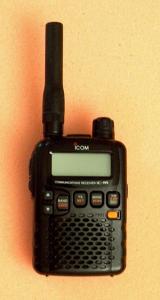|
|
home |
scanner |
rig |
HT antenna |
base antenna |
links |
e-mail me
|
Home -> Scanner

-
This is my first piece of ham gear - my trusty Icom IC-R5 wideband receiver.
It is outfitted with a stubby antenna. I can take this receiver
everywhere. It fits nicely in my back pocket.
I did a lot of shopping before deciding on the right scanner for me.
Being new at this, I want something that can be used at home, and
also can be carried around. So I've narrowed the choices down to
handheld scanners.
-
Wideband - The Icom IC-R5 can receive frequencies from shortwave to microwave.
So with one radio, I can pick up any frequencies I like to scan.
One of the important features I considered was sensitivity. Comparing
specs of different handheld scanners and HT's, the IC-R5 has one of the
highest sensitivity ratings in all bands. Of course, you get what you
pay for, and in the SW band and above 800MHz, the IC-R5 isn't going to
compare with dedicated equipment for those bands. It also doesn't have
SSB, which would be useful in the SW band. However, it can receive
AM, NFM, WFM on all bands, which meets my everyday scanning needs.
|
|
|
|
